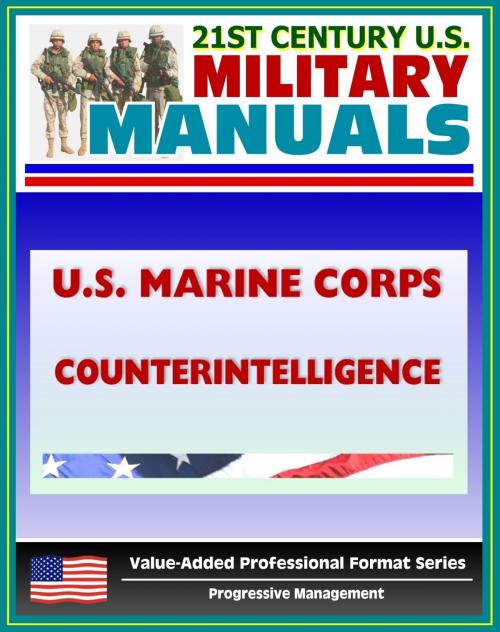21st Century U.S. Military Manuals: U.S. Marine Corps (USMC) Counterintelligence (Value-Added Professional Format Series)
Nonfiction, History, Military, Naval| Author: | Progressive Management | ISBN: | 9781465955562 |
| Publisher: | Progressive Management | Publication: | February 17, 2012 |
| Imprint: | Smashwords Edition | Language: | English |
| Author: | Progressive Management |
| ISBN: | 9781465955562 |
| Publisher: | Progressive Management |
| Publication: | February 17, 2012 |
| Imprint: | Smashwords Edition |
| Language: | English |
Part of our value-added professional format series of U.S. military manuals, this U.S. Marine Corps manual details doctrine, tactics, techniques, and procedures for the conduct of counterintelligence (CI) operations in support of the Marine air-ground task force (MAGTF). The primary target audience of this publication is intelligence personnel responsible for the planning and execution of CI operations. Commanders, planners, and other personnel who use the results from CI operations or provide support to them should also read this publication.
Intelligence strives to accomplish two objectives. First, it provides accurate, timely, and relevant knowledge about the enemy (or potential enemy) and the surrounding environment. The primary objective of intelligence is to support decisionmaking by reducing uncertainty about the hostile situation to a reasonable level, recognizing that the fog of war renders anything close to absolute certainty impossible. The second intelligence objective assists in protecting friendly forces through counterintelligence (CI). CI includes active and passive measures intended to deny the enemy valuable information about the friendly situation. CI includes activities related to countering hostile espionage, subversion, and terrorism. CI directly supports force protection operations by helping the commander deny intelligence to the enemy and plan appropriate security measures. The two intelligence objectives demonstrate that intelligence possesses positive—or exploitative—and protective elements. It uncovers conditions that can be exploited and simultaneously provides warning of enemy actions. Thus, intelligence provides the basis for our own actions, both offensive and defensive. Identifying, planning, and implementing MAGTF operations and measures are the main focus of this publication.
CI definition: Information gathered and activities conducted to protect against espionage, other intelligence activities, sabotage, or assassinations conducted by or on behalf of foreign governments or elements thereof, foreign organizations, or foreign persons, or international terrorist activities. (Joint Publication [JP] 1-02)
As a bonus, this reproduction includes the Marine Corps Manual, the basic publication of the United States Marine Corps issued by the Commandant of the Marine Corps and approved by the Secretary of the Navy - sold separately for $7.99. It is a regulatory publication for the Department of the Navy as defined in U.S. Navy Regulations. The Marine Corps Manual is designed primarily for use by Marine Corps commanders and their staffs, Navy officers exercising command over Marines, the staff of the Commandant of the Marine Corps, and the staffs of the bureaus and offices of the Navy Department. Contents: Chapter 1 - General Administration And Management * Chapter 2 - Manpower * Chapter 3 - Operations And Readiness * Chapter 4 - Logistics
Part of our value-added professional format series of U.S. military manuals, this U.S. Marine Corps manual details doctrine, tactics, techniques, and procedures for the conduct of counterintelligence (CI) operations in support of the Marine air-ground task force (MAGTF). The primary target audience of this publication is intelligence personnel responsible for the planning and execution of CI operations. Commanders, planners, and other personnel who use the results from CI operations or provide support to them should also read this publication.
Intelligence strives to accomplish two objectives. First, it provides accurate, timely, and relevant knowledge about the enemy (or potential enemy) and the surrounding environment. The primary objective of intelligence is to support decisionmaking by reducing uncertainty about the hostile situation to a reasonable level, recognizing that the fog of war renders anything close to absolute certainty impossible. The second intelligence objective assists in protecting friendly forces through counterintelligence (CI). CI includes active and passive measures intended to deny the enemy valuable information about the friendly situation. CI includes activities related to countering hostile espionage, subversion, and terrorism. CI directly supports force protection operations by helping the commander deny intelligence to the enemy and plan appropriate security measures. The two intelligence objectives demonstrate that intelligence possesses positive—or exploitative—and protective elements. It uncovers conditions that can be exploited and simultaneously provides warning of enemy actions. Thus, intelligence provides the basis for our own actions, both offensive and defensive. Identifying, planning, and implementing MAGTF operations and measures are the main focus of this publication.
CI definition: Information gathered and activities conducted to protect against espionage, other intelligence activities, sabotage, or assassinations conducted by or on behalf of foreign governments or elements thereof, foreign organizations, or foreign persons, or international terrorist activities. (Joint Publication [JP] 1-02)
As a bonus, this reproduction includes the Marine Corps Manual, the basic publication of the United States Marine Corps issued by the Commandant of the Marine Corps and approved by the Secretary of the Navy - sold separately for $7.99. It is a regulatory publication for the Department of the Navy as defined in U.S. Navy Regulations. The Marine Corps Manual is designed primarily for use by Marine Corps commanders and their staffs, Navy officers exercising command over Marines, the staff of the Commandant of the Marine Corps, and the staffs of the bureaus and offices of the Navy Department. Contents: Chapter 1 - General Administration And Management * Chapter 2 - Manpower * Chapter 3 - Operations And Readiness * Chapter 4 - Logistics















